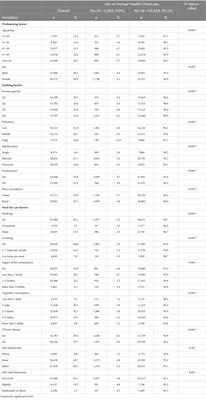Factors Associated with the Use of Annual Health Checkups in Thailand: Evidence from a National Cross-sectional Health and Welfare Survey
Introduction: Thailand has provided free annual health checkups (AHC) since universal health coverage began in 2002.However, evidence regarding the equitable use of AHC is scarce.

. Thus, this study explored factors associated with the use of AHC in Thailand. Methods: A cross-sectional study was conducted using data from the national 2015 Health and Welfare Survey. Respondents aged 15 years or above (n=57,343) were selected as the study sample. Descriptive statistical analysis and multivariable binary logistic regression were conducted to examine the association between the use of AHC and factors selected on the basis on Andersen’s Behavioral Model of Access to Medical Care. Results: Among the study sample, approximately 4.9% (n=2,815) had used AHC during the past year. Regarding predisposing factors, the use of AHC was positively related to age (e.g., over 61 vs. 15–30: AOR=2.90 [95% CI=2.40–3.52], p<0.001) and female sex (AOR=1.23 [95% CI=1.12–1.35] p<0.001). For enabling factors, the AHC use was positively associated with income (e.g., Q4 vs. Q1: AOR=1.98 [95% CI=1.75–2.25], p<0.001), education (e.g., high vs. low: AOR=3.11 [95% CI=2.75–3.51], p<0.001), being married (e.g., vs. single: AOR=1.27 [95% CI=1.11–1.46], p<0.001), and urban residency (AOR=1.12 [95% CI=1.04–1.22], p=0.006). For need-for-care factors, the AHC use was positively related to chronic disease (AOR=1.26 [95% CI=1.15–1.38], p<0.001), non-smoking (e.g., vs. daily: AOR=1.18 [95% CI=1.03–1.36], p=0.015), non-drinking (e.g., vs. 3–4 times per week: AOR=1.26 [95% CI=1.04–1.53], p=0.016), and vegetable consumption (e.g., over 5 ladles vs. below 1 ladle: AOR=1.86 [95% CI=1.50–2.31], p<0.001). Conclusions: The results indicate that health awareness could play a significant role in the use of AHC. Individuals with high socioeconomic status (e.g., high-income people) and those with low-risk health behaviors (e.g., non-smokers) generally have a high interest in health and well-being. This may have been the primary reason for the high use of AHC among these groups. Thus, the government should continue to promote the public’s health awareness through various public campaigns and education programs to increase the use of AHC..
Read the full article at the original website
References:
